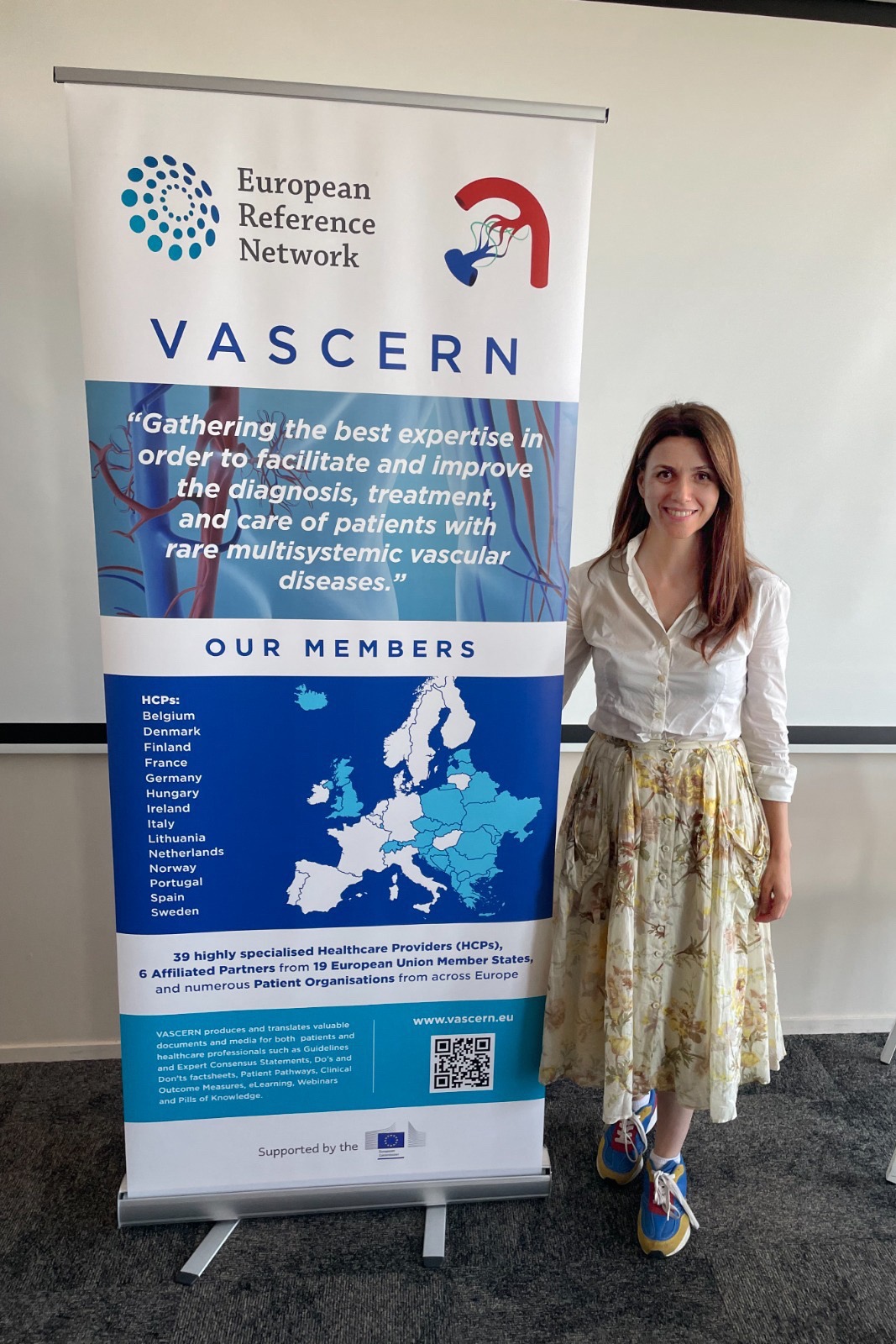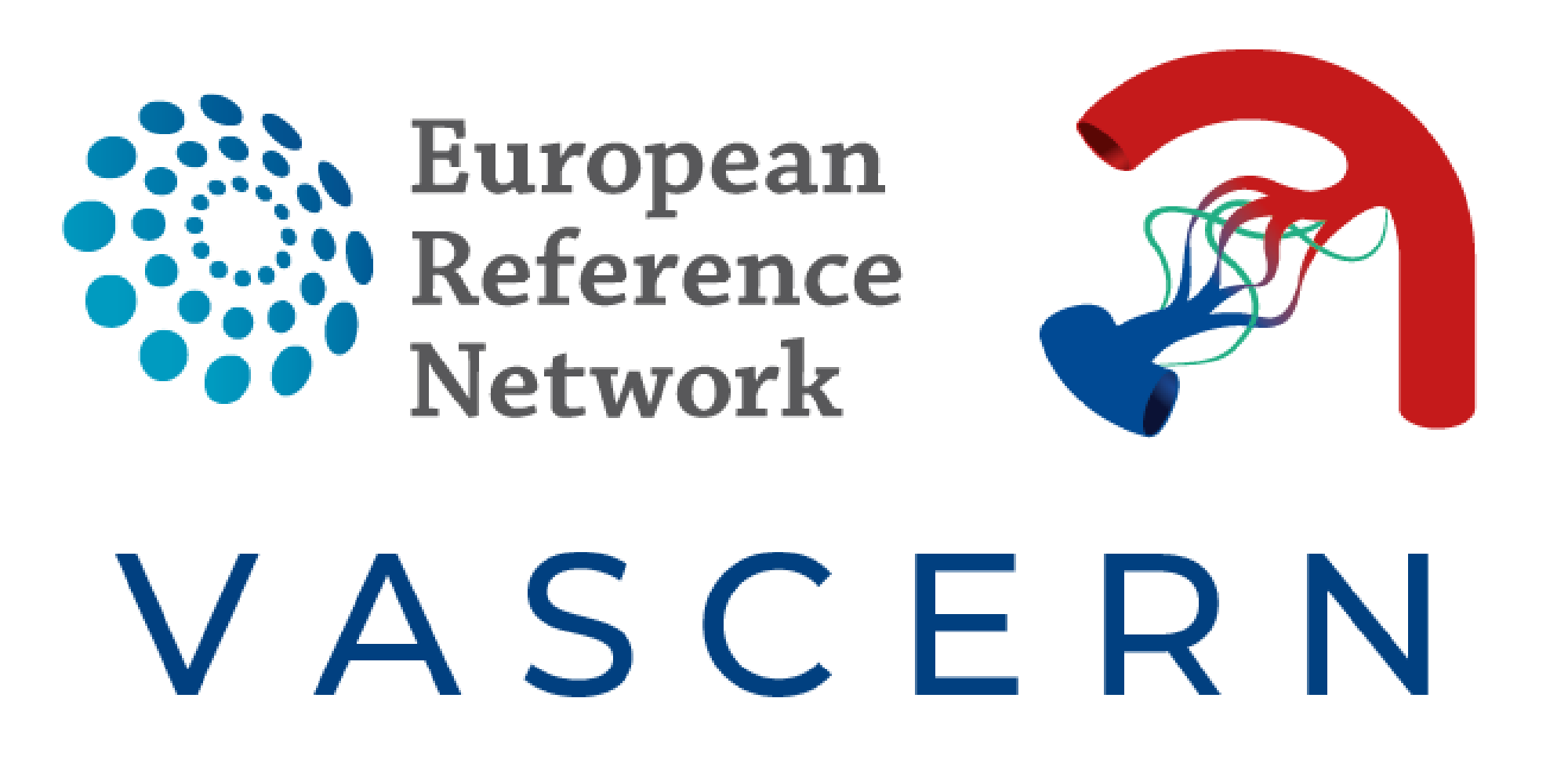In this month’s VASCERN Spotlight, we are excited to feature an interview with Eva Collado González, a patient advocate and European Patient Advocacy Group (ePAG) Co-Chair for the Medium Sized Arteries Working Group (MSA-WG). Eva shares her journey to diagnosis and her motivation as a patient advocate.

1. Can you share your personal journey or experiences that motivated you to become an advocate for rare diseases?
My journey to diagnosis was a very long one. Throughout all my life, I had been visiting several specialists in order to know what was happening to me. As a young adult, I lived in several countries, and my quest continued there, unfortunately with no luck. After many years of struggling and visiting a number of specialists in different countries, I got a hint from an educated patient and contacted the patient organization in my country, Spain. Thanks to their guidance and support, I luckily found one expert doctor in my pathology that diagnosed me.
One big question was solved: I had been diagnosed. But this led to new questions that started to arise. And answers were not easy to find.
I joined ANSEDH (the Spanish Patient Organization for Ehlers-Danlos Syndrome and Hypermobility Spectrum Disorder) and realized that I was not alone in this situation; on the contrary, most members of the community shared it. Many questions but too few answers, which came mainly from the educated and empowered patients.
I realized the importance of raising awareness so that others could be diagnosed; of educating and empowering patients to guide their communities in the search for knowledge; of patient organizations that provide critical support to patients and their families; and of patient advocacy as the way to achieve better healthcare. Ultimately, I realized the impact all of this had on the quality of life of people living with rare diseases.
2. What inspired your decision to become an ePAG advocate patient representative within VASCERN?
I had heard about the ERNs, and VASCERN in particular, from patient advocates at other patient organizations and had always admired the work they were accomplishing.
A colleague from the Spanish patient organization ANSEDH envisioned this for our patient community, and when she offered me the opportunity to become ANSEDH’s ePAG advocate in VASCERN, I was overwhelmed, but I could only say yes.
It was an amazing opportunity to be part of a European network of highly specialized experts, the best in rare vascular diseases, working together with patient advocates to serve the patient community.
Besides, I would be able to collaborate in disseminating all the opportunities that VASCERN offered throughout Europe, especially the high-quality knowledge generated and the CPMS, the system that allows consulting the experts in VASCERN about the most complex cases in rare vascular diseases.
And last but not least, it would make possible for ANSEDH to share and collaborate with other European patient organizations and ePAG advocates, thus enlarging our network and getting the Spanish patient community in the picture.
I truly believe in European cross-border cooperation at all levels, both for healthcare providers and patient organizations. Actually, I am also an ePAG advocate in ReCONNET, another ERN. The more international we become, the better it will be for the patient community.
3. What are your aspirations or hopes as a patient representative ePAG advocate within VASCERN?
As I mentioned earlier, I believe in the strength of the ERNs and therefore I aim to achieve a wide community of rare vascular disease patient organizations across Europe.
I would also like to encourage joint efforts and cooperation in building a common strategy as the VASCERN European Patient Advocacy Group (ePAG). Furthermore, the sharing of best practices and initiatives between all disease groups within VASCERN would enable the generation of knowledge and materials that would be of practical use and positive impact for the patient community.
The high quality knowledge and material generated in VASCERN is a reference point for many, but it could reach an even wider community by breaking the language barrier and translating it into as many languages as possible.
My fellow ePAG advocates play an important role; a tight team is essential to me. I would like all of them to feel included and motivated, and that they have the opportunity and space to develop and contribute, and to do their best to make a difference in the lives of people living with rare vascular diseases. Our last ePAG Spring Meeting in Paris was a very good opportunity to foster teamwork and strengthen our bonds. Having everyone on board is the key to success!
Another goal is to further strengthen the partnership with clinicians. Working side by side on fulfilling projects is a wonderful learning opportunity for both teams.
4. Can you tell us a little about your rare disease and/or the patient association that you represent?
Vascular Ehlers-Danlos Syndrome (known as vEDS) is one of 13 types of Ehlers-Danlos Syndrome (EDS). vEDS is a genetic disorder that affects the body’s connective tissue. Connective tissue provides support, protection, and structure throughout the body; it holds all of the body’s cells, organs, and tissues together. Connective tissue is made up of proteins. The protein involved in vEDS is called collagen.
vEDS is caused by genetic variants (changes) in the genes COL3A1 and COL1A1, which tell the body how to make collagen. These variants can result in faulty collagen III or I throughout the body, or a reduction in the amount of normal collagen III or I in the body (depending on the type of variant). This causes the features and medical problems associated with vEDS.
Because collagen is found throughout the body, vEDS can affect many different parts of the body, including the arteries, hollow organs, skin, and lungs. It causes blood vessels and organs to become extremely fragile and prone to tearing.
Complications of vEDS can be life-threatening and include aneurysm, dissection and rupture of arteries and rupture of organs. vEDS can also cause a variety of other symptoms, including extensive bruising and spontaneous pneumothorax.
vEDS is a rare disease affecting approximately 1 in 100,000 to 200,000 people. vEDS is included in the Medium-Sized Arteries Working Group (MSA-WG) within VASCERN.
More information about vEDS can be found at:
https://thevedsmovement.org
https://www.ehlers-danlos.com/what-is-eds/vascular-ehlers-danlos-syndrome-veds/#1677083331463-eb88c7f2-2c85
https://www.annabelleschallenge.org
https://vascern.eu/groupe/medium-sized-arteries/diseases-covered/
I represent and am endorsed by ANSEDH, Asociación Nacional del Síndrome de Ehlers-Danlos e Hiperlaxitud. It is the Spanish patient organization for Ehlers-Danlos Syndrome and Hypermobility Spectrum Disorder.
It was created in 2012 as a regional patient organization for vascular Ehlers-Danlos syndrome by a courageous mother who was looking for answers and was convinced of the strength of a patient community. She was (and still is) convinced that knowledge and research are the only way to improve healthcare and quality of life for patients and to find a cure for vEDS.
In 2016, ANSEDH became a national organization and opened its doors to all types of EDS. Today we are 500 members all over Spain.
5. What is one thing that you would like the public to know about living with a rare vascular disease (or caring for someone with a rare vascular disease)?
I would say that self-advocacy is paramount when living with a rare vascular disease and a need that needs to be addressed.
People living with a rare vascular disease live with constant uncertainty. They are constantly wondering if the clinicians they are seeing have the knowledge of their disease to provide the right care. This becomes even more dramatic when faced with an emergency. They fear that going to the emergency room could be risky. Will the health care professionals know about their disease? Will they provide the appropriate care?
It is important for these patients and caregivers to stay informed and educated so that they can guide healthcare providers who are unfamiliar with their disease. They are encouraged to always carry an information kit and an emergency kit with their medical information and guidelines for their disease.
It is also important for these patients and caregivers to work with their specialists to plan their healthcare.
6. How does raising awareness and providing education contribute to enhancing the quality of life for patients living with rare vascular diseases, and how do you contribute to these aspects as a patient representative in VASCERN?
Greater awareness and education will lead to greater dissemination of knowledge among both healthcare providers and the patient community. This would have a triple positive effect.
On the one hand, healthcare professionals would have the tools and knowledge to properly treat patients affected by a rare vascular disease. They would also gain knowledge and experience of these diseases, making it easier for these professionals to diagnose them.
On the other hand, educated patients would be empowered to guide and provide scientific information to healthcare professionals who are not yet familiar with their rare vascular disease.
Finally, institutions would be aware of the existence and needs of patients living with rare vascular diseases and it would be easier for the patient community to demand measures to improve their healthcare and quality of life.
As an ePAG advocate, I contribute by bringing the voice of the patient community and our point of view to each activity carried out in the working groups within VASCERN.
7. How do you see VASCERN and the ERNs contributing to shaping the future of healthcare, particularly for patients with rare diseases?
Firstly, ERNs contribute to the creation of networks, both at European and national level.
With more specialists connected through these networks, the dissemination and exchange of knowledge would increase and be enriched by a wider participation. This will also have a profound impact on the research environment, enhancing cross-national studies and projects.
The creation of European registries, led by the ERNs, will allow the collection of updated cross-border data. For rare diseases, mapping the situation of these patients is of paramount importance in order to raise awareness and gain more knowledge about these diseases.
The ERN organization can be seen as a starting point for other national or regional health systems. Moreover, the participation of patient advocates in the activities of the ERNs will serve as a reference for the involvement of the patient community in other healthcare environments.
Finally, cross-border care through the CPMS, which is the ultimate goal of the ERNs, will provide access to experts for rare disease patients who cannot find suitable specialists in their area without having to travel – the knowledge will travel instead.

